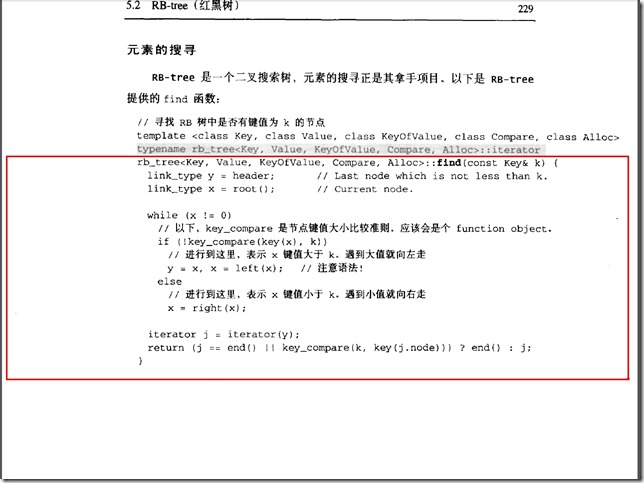STL map、set中key为结构体的用法
下面是map定义的结构:
// TEMPLATE CLASS map template<class _Kty, class _Ty, class _Pr = less<_Kty>, class _Alloc = allocator<pair<const _Kty, _Ty> > > class map : public _Tree<_Tmap_traits<_Kty, _Ty, _Pr, _Alloc, false> > { // ordered red-black tree of {key, mapped} values, unique keys public: typedef map<_Kty, _Ty, _Pr, _Alloc> _Myt; typedef _Tree<_Tmap_traits<_Kty, _Ty, _Pr, _Alloc, false> > _Mybase; typedef _Kty key_type; typedef _Ty mapped_type; typedef _Ty referent_type; // retained typedef _Pr key_compare; typedef typename _Mybase::value_compare value_compare; typedef typename _Mybase::allocator_type allocator_type; typedef typename _Mybase::size_type size_type; typedef typename _Mybase::difference_type difference_type; typedef typename _Mybase::pointer pointer; typedef typename _Mybase::const_pointer const_pointer; typedef typename _Mybase::reference reference; typedef typename _Mybase::const_reference const_reference; typedef typename _Mybase::iterator iterator; typedef typename _Mybase::const_iterator const_iterator; typedef typename _Mybase::reverse_iterator reverse_iterator; typedef typename _Mybase::const_reverse_iterator const_reverse_iterator; typedef typename _Mybase::value_type value_type; map() : _Mybase(key_compare(), allocator_type()) { // construct empty map from defaults } explicit map(const key_compare& _Pred) : _Mybase(_Pred, allocator_type()) { // construct empty map from comparator } map(const key_compare& _Pred, const allocator_type& _Al) : _Mybase(_Pred, _Al) { // construct empty map from comparator and allocator } template<class _Iter> map(_Iter _First, _Iter _Last) : _Mybase(key_compare(), allocator_type()) { // construct map from [_First, _Last), defaults _DEBUG_RANGE(_First, _Last); for (; _First != _Last; ++_First) this->insert(*_First); } template<class _Iter> map(_Iter _First, _Iter _Last, const key_compare& _Pred) : _Mybase(_Pred, allocator_type()) { // construct map from [_First, _Last), comparator _DEBUG_RANGE(_First, _Last); for (; _First != _Last; ++_First) this->insert(*_First); } template<class _Iter> map(_Iter _First, _Iter _Last, const key_compare& _Pred, const allocator_type& _Al) : _Mybase(_Pred, _Al) { // construct map from [_First, _Last), comparator, and allocator _DEBUG_RANGE(_First, _Last); for (; _First != _Last; ++_First) this->insert(*_First); } #if _HAS_STRICT_CONFORMANCE void erase(iterator _Where) { // erase element at _Where _Mybase::erase(_Where); } size_type erase(const key_type& _Keyval) { // erase and count all that match _Keyval return (_Mybase::erase(_Keyval)); } void erase(iterator _First, iterator _Last) { // erase [_First, _Last) _Mybase::erase(_First, _Last); } #endif /* _HAS_STRICT_CONFORMANCE */ mapped_type& operator[](const key_type& _Keyval) { // find element matching _Keyval or insert with default mapped iterator _Where = this->lower_bound(_Keyval); if (_Where == this->end() || this->comp(_Keyval, this->_Key(_Where._Mynode()))) _Where = this->insert(_Where, value_type(_Keyval, mapped_type())); return ((*_Where).second); } };
less的定义
template<class _Ty> struct less : public binary_function<_Ty, _Ty, bool> { // functor for operator< bool operator()(const _Ty& _Left, const _Ty& _Right) const { // apply operator< to operands return (_Left < _Right); } };
从上面定义可以看出,map<_Kty, _Ty, _Pr, _Alloc>的后两个默认的参数,class _Pr = less<_Kty> , class _Alloc = allocator<pair<const _Kty, _Ty> > >;
而默认缺省定义map时,此时如果结构体为key值时,而此时class _Pr = less<_Kty>要进行_Left < _Right,而如果此时结构体没有<方法时,则会出错。
解决上面问题有两种方法:1.在结构体重重载<操作符;2.定义自己的排序函数,显式调用。
1.结构体中重载<
#include <iostream> #include <string> #include <map> using namespace std; struct StructTest { string sTemp; int nCount; bool operator<(const StructTest& test) const { if (sTemp < test.sTemp) { return true; } else if (sTemp == test.sTemp) { if (nCount < test.nCount) return true; else return false; } else { return false; } } }; void main() { map<StructTest,string>mapTest; map<StructTest,string>::iterator mapTestiter; StructTest StructTest1,StructTest2,StructTest3; StructTest1.sTemp="111111"; StructTest1.nCount=6; StructTest2.sTemp="111111"; StructTest2.nCount=7; StructTest3.sTemp="000000"; StructTest3.nCount=6; mapTest.insert(make_pair(StructTest1,"1")); mapTest.insert(make_pair(StructTest2,"2")); mapTest.insert(make_pair(StructTest3,"3")); for (mapTestiter=mapTest.begin();mapTestiter!=mapTest.end();mapTestiter++) { cout<<(mapTestiter->first).sTemp<<" "<<(mapTestiter->first).nCount<<" "<<mapTestiter->second<<endl; } }
2.定义自己的排序函数,显式调用
#include <iostream> #include <string> #include <map> using namespace std; struct StructTest { string sTemp; int nCount; }; struct ptr_less : public binary_function<StructTest,StructTest,bool> { bool operator()(const StructTest& test1, const StructTest& test2) const { if (test1.sTemp < test2.sTemp) { return true; } else if (test1.sTemp == test2.sTemp) { if (test1.nCount < test2.nCount) return true; else return false; } else { return false; } } }; void main() { map<StructTest,string,ptr_less>mapTest; map<StructTest,string,ptr_less>::iterator mapTestiter; StructTest StructTest1,StructTest2,StructTest3; StructTest1.sTemp="111111"; StructTest1.nCount=6; StructTest2.sTemp="111111"; StructTest2.nCount=7; StructTest3.sTemp="000000"; StructTest3.nCount=6; mapTest.insert(make_pair(StructTest1,"1")); mapTest.insert(make_pair(StructTest2,"2")); mapTest.insert(make_pair(StructTest3,"3")); for (mapTestiter=mapTest.begin();mapTestiter!=mapTest.end();mapTestiter++) { cout<<(mapTestiter->first).sTemp<<" "<<(mapTestiter->first).nCount<<" "<<mapTestiter->second<<endl; } }
当然其中的find方法也与_Pr有关。
map中find调用红黑树的find
具体调用如下:1.map中的find
2.红黑树中find
注意:STL中的SET与map一样。
具体调用可以查看STL源码剖析、或者vs中查看相关定义
天道酬勤 循序渐进 技压群雄







